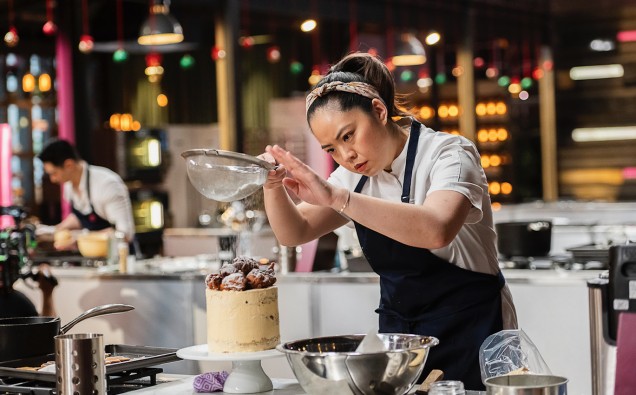Chef Kay-Lene Tan (Instagram A/c: kaylenetan_ ) was raised in Singapore but was born in Melbourne, Australia. In 2013, she made her way back to Melbourne, Australia. She worked in documentary production before she became a chef. At the age of 24, she decided to change careers after experiencing what she called a “quarter life crisis.” Before having the chance to work with Chef Joel Robuchon at his flagship restaurant in Singapore for two years, she enrolled in a trade school in that country. She then found herself working with her mentor, Chef Andres Lara, at Pollen. She spent eight years as the executive pastry chef of the Tonka and Coda restaurants in the Melbourne CBD after returning to Melbourne, and she later moved on to the Executive Pastry Chef position at the Ritz-Carlton, Melbourne, where she remained until August 2023. She currently works with Chef Adam D’Sylva on a new eatery called Decca, which is set to open in the first half of 2024.
Q.) Please tell us about your Masterchefau experience.
Chef Kay: It was a once-in-a-lifetime opportunity. It was extremely humble to have the chance to stand next to so many chefs who I regard as industry legends. I gained a lot of knowledge from the experience. We had such amazing friendships and camaraderie while working on the show!
Q.) What challenges did you have to overcome to succeed in life?
Chef Kay: It was difficult for me to find my voice and learn how to stand up for myself when I first started because the kitchen was still relatively male-dominated. Honestly, the road to where I am now has been a long and winding one. Chefs I’ve met have also told me I won’t amount to anything in the industry, but all of their criticism has only inspired me to work even harder to succeed and disprove their predictions. To reach this point in my career, I have had to put in a great deal of sacrifice, hard work, and dedication.
Q.) How would you describe your cooking style?
Chef Kay: I enjoy making desserts that convey a story, whether it be about a person who has inspired me or about my own experiences. Nothing brings me greater joy than hearing someone enjoy a dessert I’ve made and remark, “Oh, this takes me back…” or “This reminds me of a time…” My Asian heritage is something I frequently incorporate into my works; it’s important to always remember where you’ve come from in order to know where you’re heading.
Q.) Where is your favorite place to dine in Singapore?
Chef Kay: I really enjoy eating at Bedok 85 Hawker Centre, even though it’s not luxurious. Meatball noodles (Bak Chor Mee), sambal stingray, glutinous rice balls (Tang Yuan) for dessert. It makes me hungry to even think about it now!
Q.) Give an overview of Singaporean cuisine.
Chef Kay: I consider myself extremely fortunate to have grown up in Singapore, where the culinary options are truly diverse. I also adore how certain dishes have changed as a result of the distinct tastes of the Singaporean palate. Similar to how much Singaporeans enjoy a good, crispy Roti Prata!
Q.) Why are hawker centres in Singapore so well-known?
Chef Kay: Hawkers have dedicated their entire lives to mastering a single dish or cooking technique. It elevates them to the status of creators. In fact, it’s amazing! When it comes to food, hawkers are the best places to get value for your money, and their food is always delicious!
Q.) Noodles, rice, and seafood are the three main components of Singaporean cuisine. What is the origin of these pillars?
Chef Kay: Due to our strategic location, Singapore was a bustling trading port at the time of its founding, attracting visitors from all over the world. Because rice and noodles were frequently the main starch in many one-dish meals, they were essentially a staple. Being an island city, one of the easiest ways to obtain protein was through seafood.
Q.) How is the food of Singapore evolving over time?
Chef Kay: Since the publication of the Michelin guide in Singapore, the number of upscale restaurants in the city-state has undoubtedly increased. Many chefs have taken humble dishes from their upbringing and transformed them into elegant dining experiences. The degree of innovation in dining options that Singapore is witnessing is truly remarkable.
Q.) What factors are all important to take into account when becoming a desert chef?
Chef Kay: A pastry chef’s ability to pay attention to detail is unquestionably essential. Because a lot of what we do requires accuracy and knowledge of ingredients. I once heard from one of my chefs that pastry is like chemistry and that measurements are crucial.
Q.) Any advice for the aspiring chef?
Chef Kay: Find a restaurant you love working at or a great mentor, and dedicate more than three months of your time to them. Becoming a sponge and soaking up as much information as you can is crucial when you’re first starting out. And enjoy the journey. A lot of young chefs are eager to open their own eateries and design menus, but in the beginning, cooking is so much more enjoyable when one is not concerned with the business side of things. When the time comes for you to take charge, the more you learn—even just by observing—the more motivated you will be. And always be humble. Being humble is crucial for chefs. I always remember Theodore Roosevelt saying, ” Keep your eyes on the stars, and your feet on the ground.”
By: Rida Khan (Aviation Author)
Instagram A/c: aviationauthor.ridakhan



















